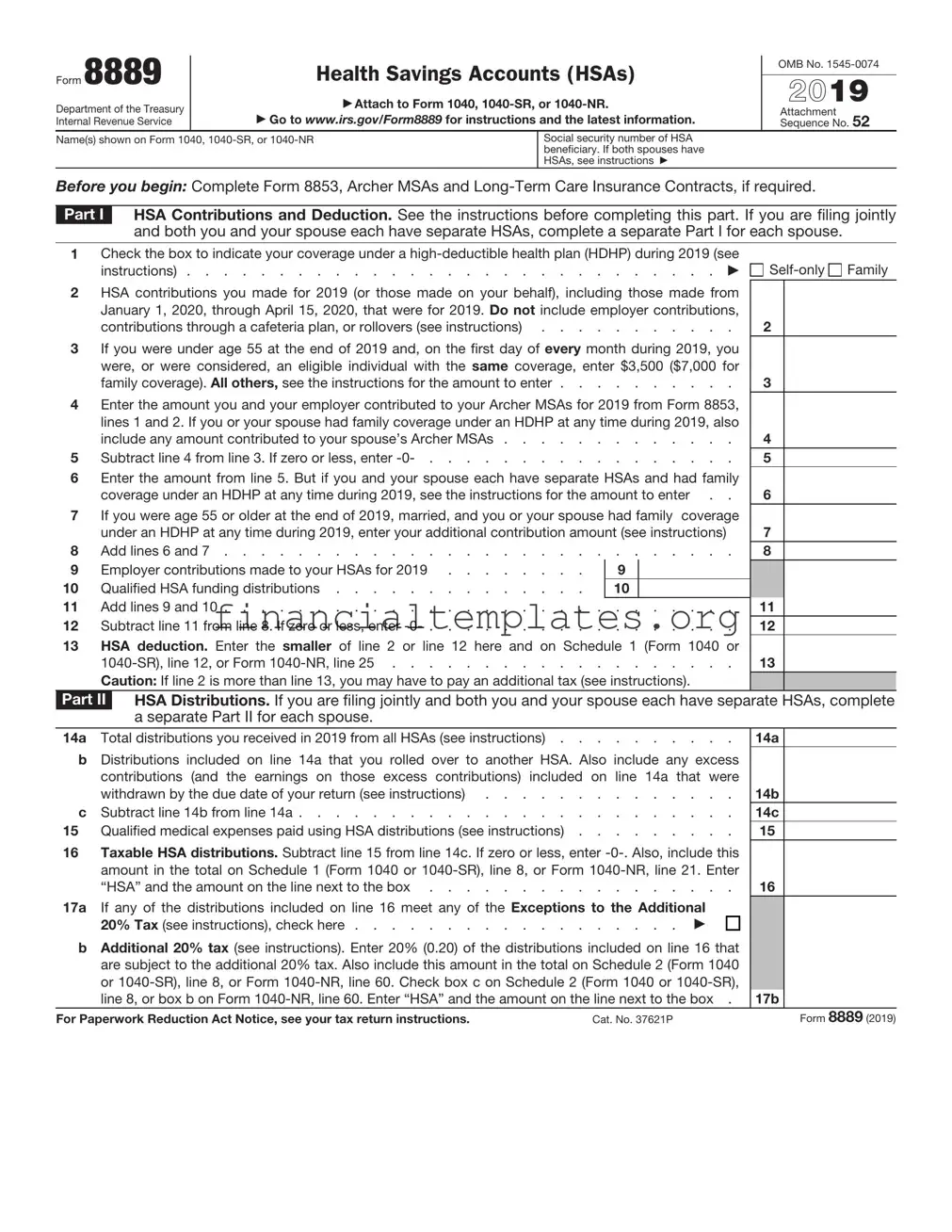Form 8889 |
|
Health Savings Accounts (HSAs) |
OMB No. 1545-0074 |
|
|
|
2021 |
Department of the Treasury |
|
▶ Attach to Form 1040, 1040-SR, or 1040-NR. |
▶ Go to www.irs.gov/Form8889 for instructions and the latest information. |
Attachment |
Internal Revenue Service |
Sequence No. 52 |
Name(s) shown on Form 1040, 1040-SR, or 1040-NR |
|
Social security number of HSA |
|
|
|
|
beneficiary. If both spouses |
|
|
|
|
have HSAs, see instructions ▶ |
|
Before you begin: Complete Form 8853, Archer MSAs and Long-Term Care Insurance Contracts, if required.
Part I HSA Contributions and Deduction. See the instructions before completing this part. If you are filing jointly and both you and your spouse each have separate HSAs, complete a separate Part I for each spouse.
1Check the box to indicate your coverage under a high-deductible health plan (HDHP) during 2021.
See instructions . . . . . . . . . . . . . . . . . . . . . . . . . . . . ▶ |
Self-only |
Family |
2HSA contributions you made for 2021 (or those made on your behalf), including those made from January 1, 2022, through April 15, 2022, that were for 2021. Do not include employer contributions,
contributions through a cafeteria plan, or rollovers. See instructions |
2 |
3If you were under age 55 at the end of 2021 and, on the first day of every month during 2021, you were, or were considered, an eligible individual with the same coverage, enter $3,600 ($7,200 for
family coverage). All others, see the instructions for the amount to enter |
3 |
4Enter the amount you and your employer contributed to your Archer MSAs for 2021 from Form 8853, lines 1 and 2. If you or your spouse had family coverage under an HDHP at any time during 2021, also
include any amount contributed to your spouse’s Archer MSAs |
4 |
5 Subtract line 4 from line 3. If zero or less, enter -0- |
5 |
6Enter the amount from line 5. But if you and your spouse each have separate HSAs and had family
coverage under an HDHP at any time during 2021, see the instructions for the amount to enter . . |
6 |
7If you were age 55 or older at the end of 2021, married, and you or your spouse had family coverage
|
under an HDHP at any time during 2021, enter your additional contribution amount. See instructions |
7 |
|
8 |
Add lines 6 and 7 |
8 |
|
9 |
Employer contributions made to your HSAs for 2021 |
9 |
|
|
|
10 |
Qualified HSA funding distributions |
10 |
|
|
|
11 |
Add lines 9 and 10 |
11 |
|
12 |
Subtract line 11 from line 8. If zero or less, enter -0- |
12 |
|
13 |
HSA deduction. Enter the smaller of line 2 or line 12 here and on Schedule 1 (Form 1040), Part II, line 13 |
13 |
|
|
Caution: If line 2 is more than line 13, you may have to pay an additional tax. See instructions. |
|
|
Part II HSA Distributions. If you are filing jointly and both you and your spouse each have separate HSAs, complete a separate Part II for each spouse.
14a Total distributions you received in 2021 from all HSAs (see instructions) . . . . . . . . . . 14a
bDistributions included on line 14a that you rolled over to another HSA. Also include any excess contributions (and the earnings on those excess contributions) included on line 14a that were
|
withdrawn by the due date of your return. See instructions |
14b |
c |
Subtract line 14b from line 14a |
14c |
15 |
Qualified medical expenses paid using HSA distributions (see instructions) |
15 |
16Taxable HSA distributions. Subtract line 15 from line 14c. If zero or less, enter -0-. Also, include this
amount in the total on Schedule 1 (Form 1040), Part I, line 8e |
. . . |
16 |
17a If any of the distributions included on line 16 meet any of the Exceptions to the Additional |
|
20% Tax (see instructions), check here |
▶ |
|
bAdditional 20% tax (see instructions). Enter 20% (0.20) of the distributions included on line 16 that are subject to the additional 20% tax. Also, include this amount in the total on Schedule 2 (Form
1040), Part II, line 17c |
. . . . . . . . . . . . . . . . . . . . . . . . . . |
17b |
Part III Income and Additional Tax for Failure To Maintain HDHP Coverage. See the instructions before completing this part. If you are filing jointly and both you and your spouse each have separate HSAs, complete a separate Part III for each spouse.
18 |
Last-month rule |
18 |
19 |
Qualified HSA funding distribution |
19 |
20Total income. Add lines 18 and 19. Include this amount on Schedule 1 (Form 1040), Part I, line 8z,
and enter “HSA” and the amount on the dotted line |
20 |
21Additional tax. Multiply line 20 by 10% (0.10). Include this amount in the total on Schedule 2 (Form
1040), Part II, line 17d |
21 |
For Paperwork Reduction Act Notice, see your tax return instructions. |
Cat. No. 37621P |
Form 8889 (2021) |

